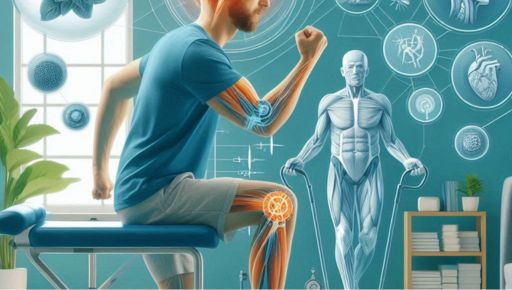The Benefits of Physiotherapy After Stroke: Regaining Strength and Mobility

A stroke can have a significant impact on an individual’s life, often leading to long-term physical, emotional, and psychological challenges. However, with proper treatment and rehabilitation, many stroke survivors can regain strength, mobility, and independence. Post-stroke physiotherapy plays a critical role in the rehabilitation process, helping individuals rebuild physical function and improve their overall quality of life. In this article, we will explore the benefits of physiotherapy after stroke, focusing on how it helps patients regain mobility and strength, and the importance of early intervention in stroke rehabilitation.
1. Restoring Movement and Function
One of the most important goals of post-stroke physiotherapy is to help patients regain mobility. After a stroke, patients may experience weakness, paralysis, or limited range of motion, particularly on one side of the body. Physiotherapists work with stroke survivors to improve muscle strength and coordination, which are essential for basic movements such as walking, sitting, standing, and performing everyday tasks.
- Targeted Exercises: Physiotherapists design personalized exercise plans to strengthen the muscles that have been weakened by the stroke. These exercises help to rebuild muscle mass, improve balance, and enhance overall movement function.
- Motor Relearning: For many stroke patients, the brain must “relearn” how to send signals to muscles. Physiotherapy helps to stimulate these pathways, often through repetitive motion exercises that encourage neuroplasticity, allowing the brain to adapt and regain some of its lost abilities.
2. Improving Balance and Coordination
After a stroke, balance and coordination can be significantly affected, making everyday tasks like walking, climbing stairs, or even standing up from a chair difficult. Physiotherapy plays a key role in improving balance, reducing the risk of falls, and helping individuals move more confidently.
- Balance Training: Physiotherapists use exercises and techniques specifically designed to improve balance, such as standing on one leg, walking heel-to-toe, and practicing weight shifts. These activities help stroke survivors rebuild their confidence and reduce the fear of falling.
- Coordination Exercises: Stroke often impacts the ability to coordinate different movements of the body. Physiotherapists guide patients through activities that challenge their coordination, such as reaching, grasping, or fine motor tasks, which gradually improve the coordination between the brain and muscles.
3. Pain Management and Reduction of Spasticity
Many stroke survivors experience pain due to muscle tightness, joint stiffness, or spasticity (muscle spasms). Post-stroke physiotherapy not only focuses on improving movement but also on managing pain and reducing spasticity, which can limit a person’s ability to move freely and comfortably.
- Stretching and Mobilization: Stretching exercises and joint mobilization techniques are commonly used by physiotherapists to relieve tension in muscles and improve flexibility. This can help alleviate discomfort and restore mobility in the affected areas.
- Heat and Cold Therapy: Physiotherapists often use heat and cold treatments to reduce inflammation and pain. These therapies can help relieve muscle spasms and provide temporary relief from the discomfort that often follows a stroke.
4. Enhancing Cardiovascular Health
Stroke survivors are at an increased risk of cardiovascular problems, and physiotherapy can also help improve cardiovascular health, which is essential for overall recovery. Physiotherapists encourage low-impact aerobic activities such as walking, cycling, or swimming to improve circulation, stamina, and heart health.
- Aerobic Exercise: Regular aerobic exercises help strengthen the heart and lungs, improve circulation, and reduce the risk of future strokes. As patients gain strength and mobility, physiotherapists can gradually increase the intensity of exercises to match their progress.
- Breathing Exercises: Stroke survivors may experience difficulty with breathing, particularly if they have lung complications or poor physical stamina. Breathing exercises are often included in physiotherapy programs to improve respiratory function and reduce fatigue.
5. Psychological Benefits and Motivation
The physical benefits of post-stroke physiotherapy are significant, but the psychological impact should not be overlooked. Many stroke survivors experience feelings of frustration, depression, and anxiety, particularly when progress is slow. Physiotherapists not only provide physical treatment but also emotional support, encouraging patients throughout their recovery journey.
- Boosting Confidence: As stroke survivors regain strength and mobility, their confidence and self-esteem improve. Physiotherapists work with patients to set achievable goals, celebrate progress, and motivate them to stay engaged in their rehabilitation process.
- Emotional Support: Physiotherapists often serve as emotional support for patients, providing encouragement and guidance to help them stay positive and focused. This support can make a significant difference in a patient’s outlook and their overall commitment to rehabilitation.
6. Personalized Rehabilitation Plans
One of the most important aspects of stroke rehabilitation is that each patient’s recovery journey is unique. Post-stroke physiotherapy is personalized to meet the specific needs of the patient, taking into account the severity of the stroke, the areas affected, and the patient’s goals for recovery.
- Tailored Exercises: Physiotherapists assess the patient’s physical capabilities and create a customized rehabilitation plan that focuses on their individual needs. These plans are adjusted as the patient progresses to ensure continuous improvement.
- Ongoing Monitoring: Physiotherapists closely monitor patients’ progress and adjust exercises accordingly. This ongoing assessment ensures that recovery is on track and that the patient is receiving the most effective treatment possible.
Physiotherapy and rehabilitation after stroke is essential for helping survivors regain strength and mobility. It plays a crucial role in improving movement, balance, coordination, and overall quality of life. By offering personalized, patient-focused care, physiotherapy empowers stroke survivors to rebuild their physical abilities, manage pain, and increase independence. The benefits of stroke rehabilitation extend beyond physical recovery, also addressing emotional and psychological well-being to help patients stay motivated and positive throughout their journey. If you or a loved one is recovering from a stroke, post-stroke physiotherapy can be an invaluable part of the recovery process, providing the tools and support needed to achieve a higher quality of life. In the hospices it is important to have a doctor orthopedist or physiotherapist.



